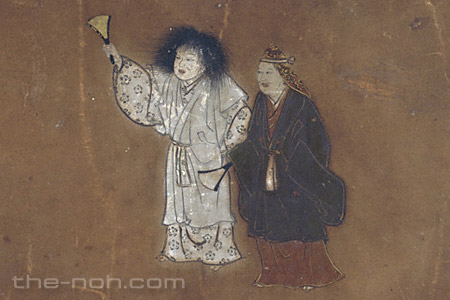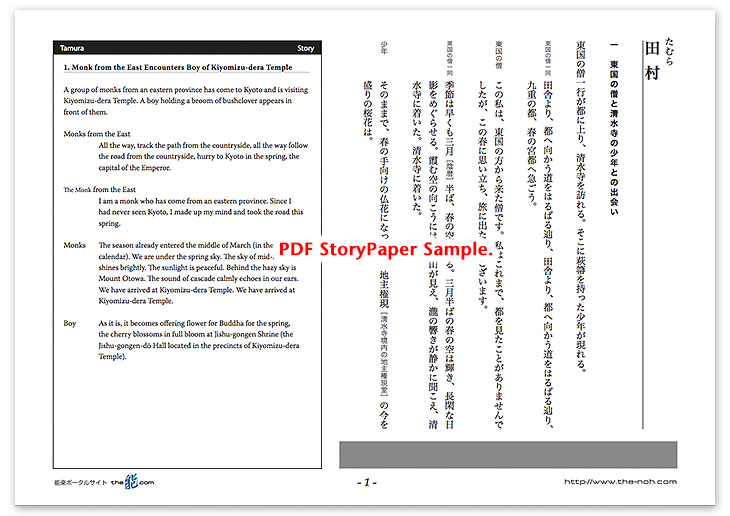
 Tamura
Tamura

![]()
One spring day, a monk from an eastern province who has come to Kyoto visits Kiyomizu-dera Temple. He meets a boy holding a broom. The boy answers that he serves Jishu-gongen Shrine. To the monk asking the history of Kiyomizu-dera Temple, the boy explains the origin of the temple established by Sakanoue no Tamuramaru (Tamuramaro). While he further lists the scenic sights nearby upon the monk’s request, the sun sets. The time shifts to a spring evening when the moon shines on the flowers. The boy and the monk recite the poem of “A Moment of Spring Evening Worth Thousands of Pieces of Gold” and enjoy the view of the cherry blossoms in the temple. The boy honors the beauty of the view and dances. He then enters a building named Tamura-dō Hall, related to Tamuramaru.
Appearing before the monk who is left behind is a man who lives in the town outside of the gate of Kiyomizu-dera Temple. He talks about the origin of Kiyomizu-dera Temple and assumes that the boy must be the ghost of Tamuramaru. When the monk, who is following the recommendation of the man, chants the Lotus Sutra to pray for the boy, the ghost of Tamuramaru in armor appears in the middle of the night. He tells the story that he once received an imperial order to conquer the enemy of the government at Mount Suzuka and to realize the security of the nation. He therefore led a force to visit Kannon, the Deity of Mercy, and prayed for divine support. Tamuramaru then shows the scene in which he masterfully defeated rebels and ends his story with appreciation for the spiritual power of Kannon.
![]()
This piece constitutes a part of the three kachi-shura stories, together with “Ebira” and “Yashima.” Kachi-shura is a type of shura-noh which features a warrior who won a battle. The main character of this piece is a shogun, Sakanoue no Tamuramaru, who served Emperor Heizei. He is not pessimistic but rather described as a brave, manly warrior. This piece takes on an auspicious atmosphere.
In the first half of the drama, the flowery view of Kiyomizu-dera Temple is featured around the boy, who is the incarnation of Tamuramaru. Especially the scene beautifully depicts a spring evening, which intoxicates people with the moonlight streaming through cherry blossoms. The graceful and bright atmosphere conspicuously captures the stage. On the other hand, in the latter half, Tamuramaru in armor appears to narrate his valor on the battlefields and shows his momentum at the times when he beat enemies down. The latter half features courage.
This piece has kuse (the core narration by shite and reciters with music) in both the first and second halves. The first half features mai-guse, kuse with graceful dance with the chanting of yowa-gin. In the second half, after i-guse (kuse recited in a sitting position) recited in the chanting of tsuyo-gin, a powerful movement pattern called kakeri continues and a dance is performed in the finale (kiri). Each feature brings forth a different atmosphere. The variation of the atmosphere in the first and second halves is the highlight of this piece.
STORY PAPER : Tamura
Story Paper presents noh chant stories in modern speech, with story outlines, highlights and more using Adobe PDF format, which can print out and zoom in. Print out the pages and take them with you when you see the actual noh performance.

The copyright of Story Paper is held by the Noh.com. Story Paper is for individual use only. It is prohibited by the copyright law to distribute or publish printed-out Story Paper pages without prior consent. For more information, check the credit and disclaimer pages.



 [Tamura : Story Paper PDF : 516KB
[Tamura : Story Paper PDF : 516KB